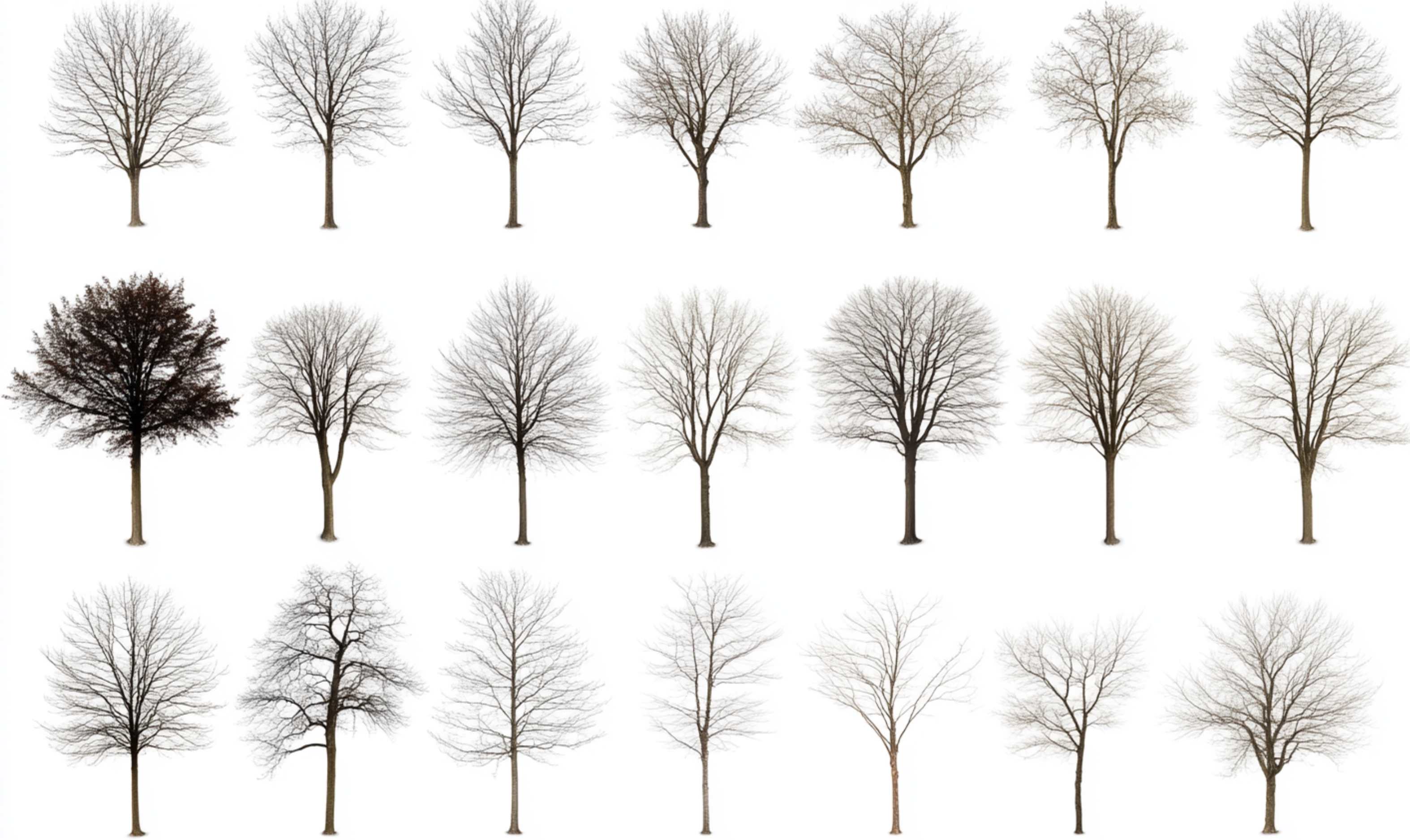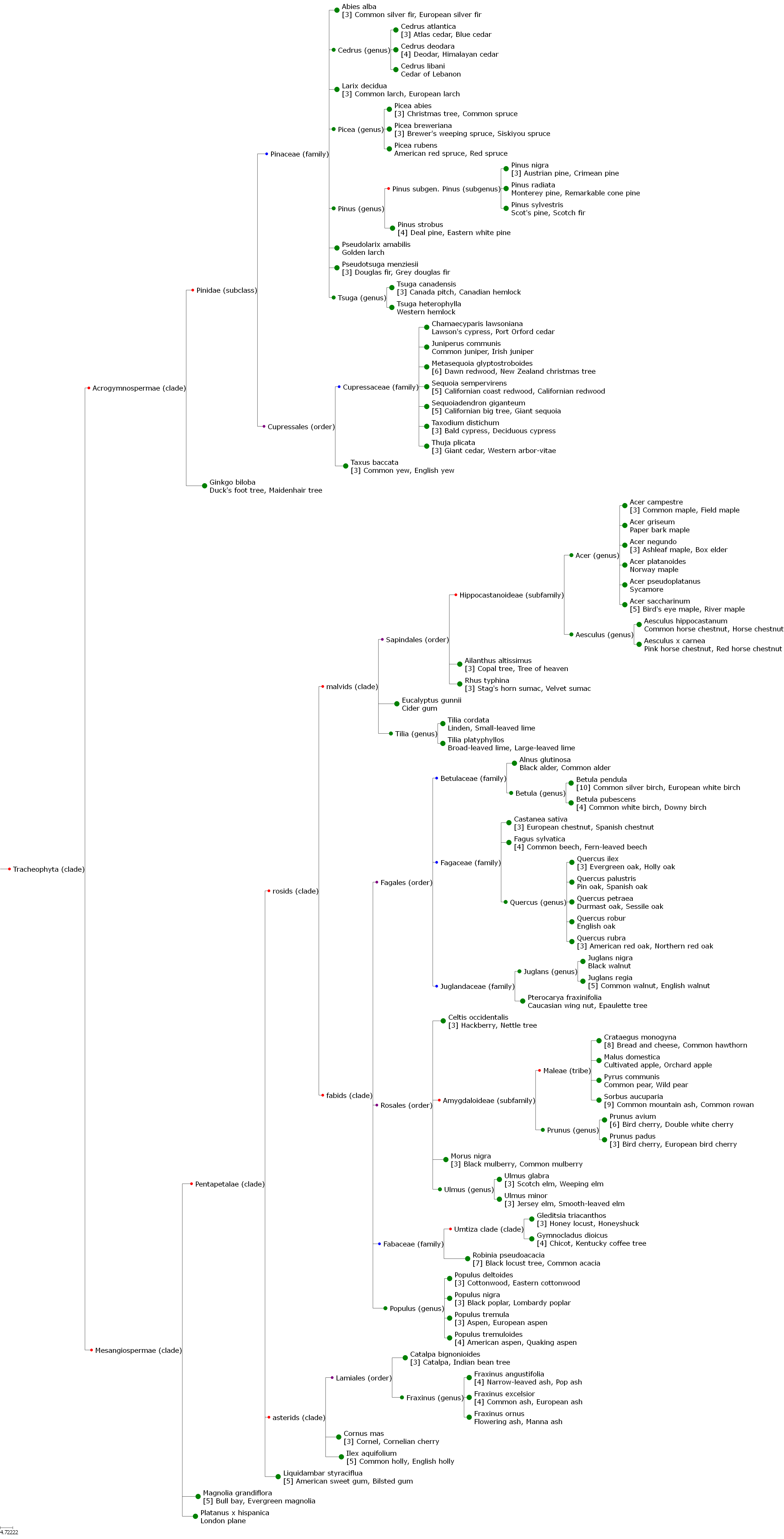01. Phylogenetic Tree for Common Species
Phylogenetic Tree
Figure 1 shows a phylogenetic tree encompassing the 77 species appearing in common trees using the NCBI database. Common names are shown below the species names. When there are more than two common names (in The Hutchinson Dictionary of Plant Names (2006)), the numbers of such is shown in square brackets followed by a sample of two. Classifications with only one child node are not shown, so for example the genus Abies does not appear because Abies alba is the only species shown. Species are highlighted with large green dots.
Clade Name Etymology
The suffix -ids is commonly used in scientific taxonomy to denote a group or clade. It comes from Greek “-idēs” (-ιδης), meaning “descendant of” or “related to.”
The name Rosids originates from the genus Rosa, which is the Latin word for rose. As a clade within the eudicots, rosids encompass a large variety of flowering plants, many of which share characteristics with or are related to the rose family, Rosaceae.
The term Malvids derives from the genus Malva, commonly known as mallow. This name traces back to the Latin malva and the Greek malakhe (μαλάχη), meaning “soft,” due to the plant’s historical use for its soothing properties in traditional medicine. Malvids are a subgroup of rosids and include economically and ecologically significant families like Brassicaceae.
Fabids take their name from the genus Faba, which refers to beans. The term comes from the Latin word for broad bean (Vicia faba), a staple crop throughout history. This clade includes the Fabaceae family, which is central to nitrogen-fixing plants and critical to agriculture and ecosystems worldwide.
Lastly, Asterids are named after the genus Aster, derived from the Greek word aster (ἀστήρ), meaning star, in reference to the star-like arrangement of their flowers’ ray and disc florets. This clade includes plants with notable diversity in flower structure, like the Asteraceae family, which comprises species such as daisies and sunflowers. Together, these names reflect botanical characteristics and historical associations across major angiosperm groups.
The Aceraceae Family
Historically, Aceraceae was recognized as its own family, primarily containing the genus Acer (maples) and Dipteronia. However, with advances in molecular phylogenetics, it became clear that these genera are better classified within the larger Sapindaceae family, as they are closely related to other members of this family based on genetic data. The current widely accepted classification places Acer in the Sapindaceae family, specifically within the Hippocastanoideae subfamily. This subfamily also includes other well-known genera like Aesculus (buckeyes and horse chestnuts).
The Hippocastanoideae Subfamily
The name Hippocastanoideae comes from the genus Aesculus, commonly known as horse chestnut trees. Hippocastanum is the species name of Aesculus hippocastanum, the horse chestnut tree. It Hippocastanum comes from Greek roots “hippos” (ἵππος): meaning “horse” and “kastanon” (κάστανον): meaning “chestnut.” The word refers to the resemblance of the fruit to true chestnuts (Castanea), though they are botanically unrelated. The name “horse chestnut” originally came from the belief that the seeds could be used to treat ailments in horses, though they are toxic to humans and many animals. The ending - -oideae is a standard botanical suffix used to denote a subfamily. It comes from the Greek suffix “-oeidēs” (οειδής), meaning “having the form of” or “resembling.” Thus, Hippocastanoideae refers to the subfamily that includes plants resembling or related to the horse chestnut (Aesculus hippocastanum).
The leaves of many maples (Acer genus) and horse chestnuts (Aesculus hippocastanum) share a resemblance in their overall structure. Both have a palmate leaf shape, where the lobes or leaflets radiate from a central point, much like the fingers of a hand. In maples, the leaves are typically simple, with 5 (sometimes 3 or 7) pointed lobes radiating from the petiole. In horse chestnuts, the leaves are compound and palmate, typically consisting of 5 (sometimes 7) leaflets arranged in a similar hand-like fashion.

